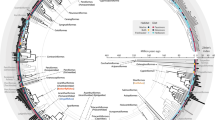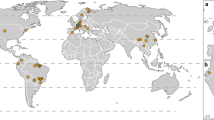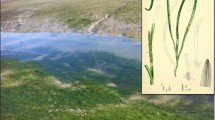Abstract
Several studies have demonstrated a latitudinal gradient in the proportion of omnivorous fish species (that is, consumers of both vegetal and animal material) in marine ecosystems. To establish if this global macroecological pattern also exists in fresh and brackish waters, we compared the relative richness of omnivorous fish in freshwater, estuarine, and marine ecosystems at contrasting latitudes. Furthermore, we sought to determine the main environmental correlates of change in fish omnivory. We conducted a meta-analysis of published data focusing on change in the relative richness of omnivorous fishes in native fish communities along a broad global latitudinal gradient, ranging from 41°S to 81.5 N° including all continents except for Antarctica. Data from streams, rivers, lakes, reservoirs, estuaries, and open marine waters (ca. 90 papers covering 269 systems) were analyzed. Additionally, the relationship between the observed richness in omnivory and key factors influencing trophic structure were explored. For all ecosystems, we found a consistent increasing trend in the relative richness of omnivores with decreasing latitude. Furthermore, omnivore richness was higher in freshwaters than in marine ecosystems. Our results suggest that the observed latitudinal gradient in fish omnivory is a global ecological pattern occurring in both freshwater and marine ecosystems. We hypothesize that this macroecological pattern in fish trophic structure is, in part, explained by the higher total fish diversity at lower latitudes and by the effect of temperature on individual food intake rates; both factors ultimately increasing animal food limitation as the systems get warmer.






Similar content being viewed by others
References
Abe SI, Uchida K, Nagumo T, Tanaka J. 2007. Alterations in the biomass-specific productivity of periphyton assemblages mediated by fish grazing. Freshw Biol 52:1486–93.
Abell R, Thieme ML, Revenga C, Bryer M, Kottelat M, Bogutskaya N, Coad B, Mandrak N, Balderas SC, Bussing W, Stiassny MLJ, Skelton P, Allen GR, Unmack P, Naseka A, Ng R, Sindorf N, Robertson J, Armijo E, Higgins JV, Heibel TJ, Wikramanayake E, Olson D, López HL, Reis RE, Lundberg JG, Sabaj Pérez MH, Petry P. 2008. Freshwater ecoregions of the world: a new map of biogeographic units for freshwater biodiversity Conservation. Bioscience 58:403–14.
Allen AP, Gillooly FJ. 2006. Assessing latitudinal gradients in speciation rates and biodiversity at the global scale. Ecol Lett 9:947–54.
Arim M, Bozinovic F, Marquet PA. 2007. On the relationship between trophic position, body mass and temperature: reformulating the energy limitation hypothesis. Oikos 116:1524–30.
Arrington DA, Winemiller KO, Loftus WF, Akin S. 2002. How often do fishes “run on empty”? Ecology 83:2145–51.
Atkinson D, Sibly R. 1997. Why are organisms usually bigger in colder environments? Making sense of a life history puzzle. Trends Ecol Evol 12:235–9.
Behrens MD, Lafferty KD. 2007. Temperature and diet effects on omnivorous fish performance: implications for the latitudinal diversity gradient in herbivorous fishes. Can J Fish Aquat Sci 64:867–73.
Blackburn TM, Gaston KJ, Loder N. 1999. Geographic gradients in body size: a clarification of Bergmann’s rule. Divers Distrib 5:165–74.
Bolser RC, Hay ME. 1996. Are tropical plants better defended? Palatability and defenses of temperate vs tropical seaweeds. Ecology 77:2269–86.
Boyero L, Pearson RG, Dudgeon D, Ferreira V, Graça MAS, Gessner MO, Boulton AJ, Chauvet E, Yule CM, Albariño RJ, Ramírez A, Helson JE, Callisto M, Arunachalam M, Chará J, Figueroa R, Mathooko JM, Gonçalves JF Jr, Moretti MS, Chará-Serna AM, Davies JN, Encalada A, Lamothe S, Buria LM, Castela J, Cornejo A, Li AOY, M’Erimba C, Villanueva VD, del Carmen Zúñiga M, Swan CM, Barmuta LA. 2011. Global patterns of stream detritivore distribution: implications for biodiversity loss in changing climates. Glob Ecol Biogeogr 21:134–41.
Brown JH, Gillooly JF, Allen AP, Savage VM, West GB. 2004. Toward a metabolic theory of ecology. Ecology 85:1771–89
Cardinale BJ. 2011. Biodiversity improves water quality through niche partitioning. Nature 472:86–9.
Carpenter SR, Kitchell JF, Hogson JR. 1985. Cascading trophic interactions and lake productivity. Bioscience 35:634–9.
Clements KD, Raubenheimer D, Choat JH. 2009. Nutritional ecology of marine herbivorous fishes: ten years on. Funct Ecol 23:79–92.
Currie DJ. 1991. Energy and large-scale patterns of animal- and plant-species richness. Am Nat 137:27–49.
Day RD, German DP, Manjakasy JM, Farr I, Hansen MJ, Tibbetts IR. 2011. Enzymatic digestion in stomachless fishes: how a simple gut accommodates both herbivory and carnivory. J Comp Physiol B 181:603–13.
Espinoza R, Wiens J, Tracy C. 2004. Recurrent evolution of herbivory in small, cold-climate lizards: breaking the ecophysiological rules or reptilian herbivory. Proc Natl Acad Sci USA 101:16819–24.
Ferreira CEL, Floeter SR, Gasparini JL, Ferreira BP, Joyeux JC. 2004. Trophic structure patterns of Brazilian reef fishes: a latitudinal comparison. J Biogeogr 31:1093–106.
Fischer AG. 1960. Latitudinal variations in organic diversity. Evolution 14:64–81.
Flecker AS, Taylor BW, Bernhardt ES, Hood JM, Cornwell WK, Cassatt SR, Vanni MJ, Altman NS. 2002. Interactions between herbivorous fishes and limiting nutrients in a tropical stream ecosystem. Ecology 83:1831–44.
Floeter S, Behrens M, Ferreira C, Paddack M, Horn M. 2005. Geographical gradients of marine herbivorous fishes: patterns and processes. Mar Biol 147:1435–47.
Freestone A, Osman R, Ruiz G, Torchin M. 2011. Stronger predation in tropics shapes species richness patterns in marine communities. Ecology 92:983–93.
Gaines SD, Lubchenco J. 1982. A unified approach to marine plantherbivore interactions II. Biogeography. Annu Rev Ecol Syst 13:111–38.
Hillebrand H. 2004. On the generality of the latitudinal diversity gradient. Am Nat 163:192–211.
Hixon MA, Brostoff WN. 1996. Succession and herbivory: effects of differential fish grazing on hawaiian coral-reef algae. Ecol Monogr 66:67–90.
Horwitz RJ. 1978. Temporal variability patterns and the distributional patterns of stream fishes. Ecol Monogr 48:307–21.
Ibañez C, Belliard J, Hughes RM, Irz P, Khamdem-Tohan A, Lamouroux N, Tedesco PA, Oberdorff T. 2009. Convergence of temperate and tropical fish assemblages. Ecography 32:658–70.
Jansson R, Dynesius M. 2002. The fate of clades in a world of recurrent climatic change: Milankovitch oscillations and evolution. Annu Rev Ecol Syst 33:741–77.
Jeppesen E, Meerhoff M, Holmgren K, González-Bergonzoni I, Teixeira-de Mello F, Declerck S, De Meester L, Søndergaard M, Lauridsen T, Bjerring R, Conde-Porcuna J, Mazzeo N, Iglesias C, Reizenstein M, Malmquist H, Liu Z, Balayla D, Lazzaro X. 2010. Impacts of climate warming on lake fish community structure and potential effects on ecosystem function. Hydrobiologia 646:73–90.
Kissling WD, Sekercioglu CH, Jetz W. 2011. Bird dietary guild richness across latitudes, environments and biogeographic regions. Glob Ecol Biogeogr 21:328–40.
Kristensen E, Baattrup-Pedersen A, Andersen H. 2011. Prediction of stream fish assemblages from land use characteristics: implications for cost-effective design of monitoring programmes. Environ Monit Assess 184:1435–48.
Lowe-McConnell RH. 1975. Fish community in tropical freshwaters: their distribution, ecology and evolution. London: Longman. p 337p.
Lundberg JG, Marshall LG, Guerrero J, Horton B, Malabarba MC, Wesselingh F. 1998. The stage for Neotropical fish diversification: a history of tropical South American rivers. In: Malabarba LR, Reis RE, Vari RP, Lucena ZM, Lucena CAS, Eds. Phylogeny and classification of Neotropical fishes. Edipucrs: Porto Alegre.
Martinez ND. 1994. Scale-dependent constraints on food-web structure. Am Nat 144:935–53.
Mccullaugh P, Nelder J. 1989. Generalized linear models. 2nd edn. Boca Raton: Chapman and Hall.
Mead GW. 1970. A history of South Pacific fishes. In: Wooster WS, Ed. Scientific explorations of the South Pacific. Washington, DC: National Academy of Sciences. p 236–51.
Meekan MG, Choat JH. 1997. Latitudinal variation in abundance of herbivorous fishes: a comparison of temperate and tropical reefs. Mar Biol 128:373–83.
Meerhoff M, Clemente JM, Teixeira de Mello F, Iglesias C, Pedersen AR, Jeppesen E. 2007. Can warm climate-related structure of littoral predator assemblies weaken clear water state in shallow lakes? Glob Change Biol 13:1888–97.
Meerhoff M, Teixeira-de Mello F, Kruk C, Alonso C, González-Bergonzoni I, Pacheco JP, Arim M, Beklioğlu M, Brucet S, Goyenola G, Iglesias C, Lacerot G, Mazzeo N, Kosten S, Jeppesen E. 2012. Environmental warming in shallow lakes: a review of effects on community structure as evidenced from space-for-time substitution approach. Adv Ecol Res (accepted).
Mittelbach GG, Schemske DW, Cornell HV, Allen AP, Brown JM, Bush MB, Harrison SP, Hurlbert AH, Knowlton N, Lessios HA, McCain CM, McCune AR, McDade LA, McPeek MA, Near TJ, Price TD, Ricklefs RE, Roy K, Sax DF, Schluter D, Sobel JM, Turelli M. 2007. Evolution and the latitudinal diversity gradient: speciation, extinction and biogeography. Ecol Lett 10:315–31.
Morrison W, Hay M. 2011. Are lower latitude plants better defended? Palatability of freshwater macrophytes. Ecology. doi:10.1890/11-0725.1.
Moss B. 2010. Climate change, nutrient pollution and the bargain of Dr Faustus. Freshw Biol 55:175–87.
Naya DE, Bozinovic F, Karasov WH. 2008. Latitudinal trends in digestive flexibility: testing the climatic variability hypothesis with data on the intestinal length of rodents. Am Nat 172:122–34.
Odum HT. 1957. Trophic structure and productivity of Silver Springs, Florida. Ecol Monogr 27:55–112.
Pianka E. 1966. Latitudinal gradients in species diversity: a review of concepts. Am Nat 100:33–46.
Power ME, Matthews WJ, Stewart AJ. 1985. Grazing minnows, piscivorous bass, and stream algae: dynamics of a strong interaction. Ecology 66:1448–56.
Pringle CM, Hamazaki T. 1997. Effects of fishes on algal response to storms in atropical stream. Ecology 78:2432–42.
Pringle CM, Hamazaki T. 1998. The role of omnivory in a neotropical stream: separating diurnal and nocturnal effects. Ecology 79:269–80.
R. Core development team. 2007. R: a language and environment for statistical computing. Vienna, Austria: R Foundation for Statistical Computing.
Rabassa J, Coronato AM, Salemme M. 2005. Chronology of the late Cenozoic Patagonian glaciations and their correlation with biostratigraphic units of the pampean region (Argentina). J South Am Earth Sci 20:81–103.
Reich PB, Oleksyn J. 2004. Global patterns of plant leaf N and P in relation to temperature and latitude. Proc Natl Acad Sci 101:11001–6.
Rezende EL, Bozinovic F, Garland TJ. 2004. Climatic adaptation and the evolution of basal and maximum rates of metabolism in rodents. Evolution 58:1361–74.
Rohde K. 1992. Latitudinal gradients in species diversity: the search for the primary cause. Oikos 65:514–27.
Romanuk T, Hayward A, Hutchings JA. 2011. Trophic level scales positively with body size in fishes. Glob Ecol Biogeogr 20:231–40.
Schemske DW, Mittelbach GG, Cornell HV, Sobel JM, Roy K. 2009. Is there a latitudinal gradient in the importance of biotic interactions? Annu Rev Ecol Evol Syst 40:245–69.
Sugihara G, Schoenly K, Trombla A. 1989. Scale invariance in food web properties. Science 245:48–52.
Teixeira-de Mello F, Meerhoff M, Pekcan-Hekim Z, Jeppesen E. 2009. Substantial differences in littoral fish community structure and dynamics in subtropical and temperate shallow lakes. Freshw Biol 54:1202–15.
Teixeira-de Mello F, Meerhoff M, Baattrup-Pedersen A, Maigaard T, Kristensen, PB, Andersen TK, Clemente JM, Fosalba C, Kristensen EA, Masdeu M, Riis T, Mazzeo N, Jeppesen E. 2012. Community structure of fish in lowland streams differ substantially between subtropical and temperate climates. Hydrobiologia 684:143–60.
Vannote RL, Minshall GW, Cummins KW, Cushing CE. 1980. The river continuum concept. Can J Fish Aquat Sci 37:130–7.
Venables W, Ripley B. 2002. Modern applied statistics with S. 4th edn. New York: Springer.
Winemiller KO. 1991. Ecomorphological diversification in lowland freshwater fish assemblages from five biotic regions. Ecol Monogr 61:343–65.
Winemiller KO, Leslie MA. 1992. Fish assemblages across a complex, tropical freshwater/marine ecotone. Environ Biol Fish 34:29–50.
Winemiller KO, Kelso-Winemiller LC, Brenkert AL. 1995. Ecomorphological diversification and convergence in fluvial cichlid fishes. Environ Biol Fish 44:235–61.
Wooton TJ, Oemke MP. 1992. Latitudinal differences in fish community trophic structure, and the role of fish herbivory in a Costa Rican Stream. Environ Biol Fish 35:311–19.
Zuur AF, Ieno EN, Elphick CS. 2009a. A protocol for data exploration to avoid common statistical problems. Methods Ecol Evol 1:1–12.
Zuur AF, Ieno EN, Walker NJ, Smith GM, Saveliev AA. 2009b. Mixed effects models and extensions in ecology with R. 1st edn. New York: Springer. p 574.
Acknowledgments
We especially thank Sergio R. Floeter for facilitating data for marine ecosystems, Anne Mette Poulsen for manuscript editing and Tinna Christensen for figure layout, and to David Currie, Janne Soininen and Michael Pace and two anonymous reviewers whose comments greatly improved this manuscript. This project was supported by the EU projects WISER and REFRESH, by CRES, CIRCE, The Danish Council for Independent Research: Natural Sciences (272-08-0406), Greenland Climate Research Centre (GCRC Greenland Climate Research Centre (GCRC), FNU (16-7745), and ANII (National Research and Innovation Agency of Uruguay) FCE 2009-2530 and FCE 2009-2749. IGB, FTM, and MM were supported by SNI-ANII and PEDECIBA (Uruguay). MM was also supported by the national award by L’Oréal-UNESCO for Women in Science, Uruguay (with support of DICyT). TD’s contribution was supported by Marie Curie Intra European Fellowship no. 255180 (PRECISE).
Author information
Authors and Affiliations
Corresponding author
Additional information
Author Contributions
IGB, MM, and EJ conceived the idea; IGB collected the data, IGB and TD applied the statistical analysis; IGB, MM, and EJ were responsible for the manuscript preparation with the collaboration of TD, FTM, and ABP.
Electronic supplementary material
Below is the link to the electronic supplementary material.
Rights and permissions
About this article
Cite this article
González-Bergonzoni, I., Meerhoff, M., Davidson, T.A. et al. Meta-analysis Shows a Consistent and Strong Latitudinal Pattern in Fish Omnivory Across Ecosystems. Ecosystems 15, 492–503 (2012). https://doi.org/10.1007/s10021-012-9524-4
Received:
Accepted:
Published:
Issue Date:
DOI: https://doi.org/10.1007/s10021-012-9524-4




